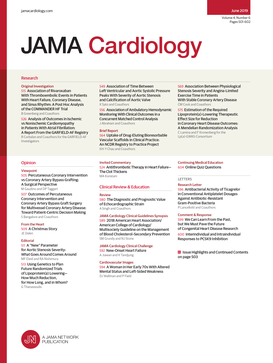OCT与血管造影指导钙化病变经皮冠状动脉介入治疗:CALIPSO随机临床试验。
IF 14.8
1区 医学
Q1 CARDIAC & CARDIOVASCULAR SYSTEMS
引用次数: 0
摘要
重要性血管内成像对钙化斑块表征和制备的应用已被提倡优于传统方法,以改善经皮冠状动脉介入治疗(PCI)的结果,但这种方法从未被评估过。目的探讨光学相干断层扫描(OCT)对钙化病变的PCI指导是否优于血管造影。设计、环境和参与者CALIPSO(钙化病变干预计划由OCT引导)试验是一项前瞻性、多中心、开放标签、随机临床试验,纳入了经冠状动脉造影计划行PCI治疗的中度至重度稳定钙化冠状动脉病变患者。该试验于2021年12月至2023年6月在法国的12个地点进行,并分析了2023年12月至2024年4月的数据。介入诊断冠状动脉造影后,符合条件的患者按1:1的比例随机分配接受oct引导的PCI或血管造影引导的PCI。在OCT组,流程以OCT分析和预定义的标准化管理算法为指导。两组患者在手术完成后对照pci后OCT分析主要终点测量。主要终点为两组OCT测量的最小支架面积(MSA)。次要关键安全终点包括术中心肌梗死、辐射剂量、造影剂体积和手术时间。结果共纳入143例患者,最终纳入134例(OCT组65例,血管造影组69例)。患者中位(IQR)年龄为73.0(66.0 ~ 78.0)岁,女性25例(18.7%)。两组的基线特征是相似的,但在OCT组中使用血管内碎石更为频繁(30例[46%]vs 8例[12%];p < 0.001)。OCT组的最终中位(IQR) MSA大于血管造影组(6.5 [5.5-8.1]mm2 vs 5.0 [4.1-6.1] mm2;p < 0.001)。两组间术中并发症发生率、造影剂体积或手术时间均无差异。结论及相关性CALIPSO随机临床试验显示,在钙化病变PCI患者中,OCT指导联合预定义算法管理比血管造影指导获得更好的支架植入效果,且无任何额外的安全性问题。临床试验注册号:NCT05301218。本文章由计算机程序翻译,如有差异,请以英文原文为准。
OCT vs Angiography for Guidance of Percutaneous Coronary Intervention of Calcified Lesions: The CALIPSO Randomized Clinical Trial.
Importance
The use of intravascular imaging for calcified plaque characterization and preparation has been advocated over conventional methods to improve percutaneous coronary intervention (PCI) outcomes, but this approach has never been evaluated.
Objective
To determine if optical coherence tomography (OCT) is superior to angiography for calcified lesions PCI guidance.
Design, Setting, and Participants
The CALIPSO (Calcified Lesion Intervention Planning Steered by OCT) trial was a prospective, multicenter, open-label, randomized clinical trial that included patients with stable moderate to severe calcified coronary lesions on coronary angiography scheduled for PCI. The trial was conducted at 12 sites in France between December 2021 and June 2023, and data were analyzed from December 2023 to April 2024.
Intervention
After diagnostic coronary angiography, eligible patients were randomly assigned in a 1:1 ratio to receive OCT-guided PCI or angiography-guided PCI. In the OCT group, the procedures were guided by OCT analysis and predefined standardized management algorithms. Patients from both arms had control post-PCI OCT analysis after procedure completion for primary end point measurement.
Main Outcomes and Measures
The primary end point was the minimal stent area (MSA) measured by OCT in both groups. Secondary key safety end points included periprocedural myocardial infarction, radiation dose, contrast medium volume, and procedure duration.
Results
A total of 143 patients were randomized, and 134 were included in the final analysis (65 in the OCT group and 69 in the angiography group). Median (IQR) patient age was 73.0 (66.0-78.0) years, and 25 patients (18.7%) were female. The baseline characteristics of the groups were comparable, but the use of intravascular lithotripsy was more frequent in the OCT arm (30 patients [46%] vs 8 patients [12%]; P < .001). The final median (IQR) MSA was larger in the OCT group than in the angiography group (6.5 [5.5-8.1] mm2 vs 5.0 [4.1-6.1] mm2; P < .001). There was no difference in periprocedural complications incidence, contrast medium volume, or procedure duration between groups.
Conclusions and Relevance
The CALIPSO randomized clinical trial showed that OCT guidance associated with predefined algorithmic management achieved better stent implantation results than angiography guidance in patients with calcified lesions PCI, without any additional safety concern.
Trial Registration
ClinicalTrials.gov Identifier: NCT05301218.
求助全文
通过发布文献求助,成功后即可免费获取论文全文。
去求助
来源期刊

JAMA cardiology
Medicine-Cardiology and Cardiovascular Medicine
CiteScore
45.80
自引率
1.70%
发文量
264
期刊介绍:
JAMA Cardiology, an international peer-reviewed journal, serves as the premier publication for clinical investigators, clinicians, and trainees in cardiovascular medicine worldwide. As a member of the JAMA Network, it aligns with a consortium of peer-reviewed general medical and specialty publications.
Published online weekly, every Wednesday, and in 12 print/online issues annually, JAMA Cardiology attracts over 4.3 million annual article views and downloads. Research articles become freely accessible online 12 months post-publication without any author fees. Moreover, the online version is readily accessible to institutions in developing countries through the World Health Organization's HINARI program.
Positioned at the intersection of clinical investigation, actionable clinical science, and clinical practice, JAMA Cardiology prioritizes traditional and evolving cardiovascular medicine, alongside evidence-based health policy. It places particular emphasis on health equity, especially when grounded in original science, as a top editorial priority.
 求助内容:
求助内容: 应助结果提醒方式:
应助结果提醒方式:


